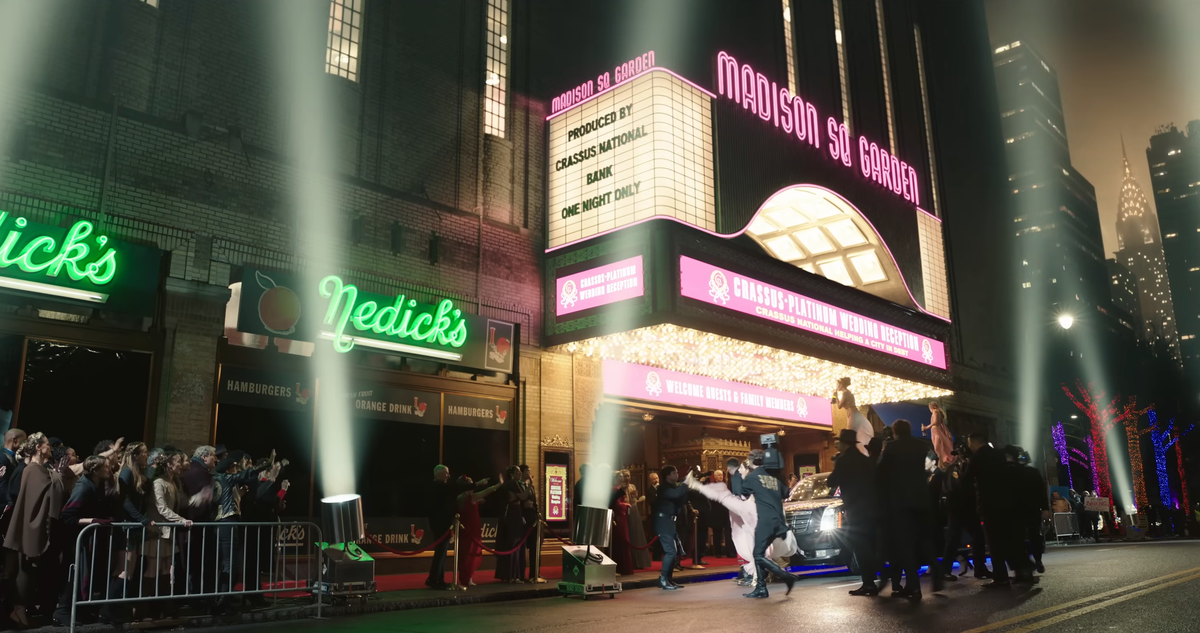There is nothing in Francis Ford Coppola’s (perhaps) final testament that feels like something out of a “normal” movie.
Photo: Francis Ford Coppola via YouTube
The moment when an actual live human walked out in front of the movie screen to pose Adam Driver’s Cesar Catilina a question (which Cesar, in the film, proceeded to answer) might, in retrospect, be one of the less bizarre moments in Francis Ford Coppola’s Megalopolis. The director’s supreme dream project, which he’s been trying to get off the ground for four decades, arrives at Cannes trailing clouds of speculation, skepticism, and controversy. It bears the marks of all the years Coppola has spent trying to make it, with elements that feel like they’ve been patched in from different periods in his filmography: a bit of The Godfather here, a bit of Tucker: the Man and His Dream there. But the movie also feels older than that. Watching it, you sense the imagination of someone who came of age in the 1950s, with its visions of scientific progress, innovative design, and space-age wonder. How odd and curiously apropos that when we do see glimpses of Coppola’s city of the future in this 2024 film, it doesn’t seem too far from something we might have seen on The Jetsons. Megalopolis comes to us as the (perhaps final) testament of an artist now in his 80s, but sometimes it feels like the fevered thoughts of a precocious child, driven and dazzled and maybe a little lost in all the possibilities of the world before him.
There is nothing in Megalopolis that feels like something out of a “normal” movie. It has its own logic and cadence and vernacular. The characters speak in archaic phrases and words, mixing shards of Shakespeare, Ovid, and at one point straight-up Latin. Some characters speak in rhyme, others just in high-minded prose that feels like maybe it should be in verse. At one point, Adam Driver does the entire “To be or not to be” soliloquy from Hamlet. Why? I’m not exactly sure. But it sure sounds good.
The plot, for all its love of science and reason, is a miasma of magic, melodrama, corny emotionality, and gangster-movie politics. It lands us right in the middle of a debate between visionary architect Cesar and this alternate-universe New York’s Mayor Cicero (Giancarlo Esposito) over how to use their limited resources when they’re already racked by debt. Cesar, inventor of a living building substance called Megalon, dreams of a self-sustaining city of the future that will organically grow with its inhabitants. Cicero, already plagued by scandal and booed wherever he goes, wants to help his angry and anxious citizens now. “Don’t let the now destroy the forever,” Cesar insists to the mayor.
Coppola, who once planned on adapting Ayn Rand’s The Fountainhead, clearly sides with the dreamer, but Cesar is an imperfect vessel. He possesses tremendous powers — in the film’s bravura opening sequence, we see him stop time as he leans precariously off the Chrysler Building — but he’s also an egomaniac, absorbed in his own brilliance and unable to compromise or care for those below him. It’s an ideal role for Driver, who combines haughtiness and neurosis better than any other actor of his generation. Cesar’s life begins to change with the arrival of Cicero’s party-girl daughter, Julia (Nathalie Emmanuel), the only other person who sees his ability to pause time, and who seems to have the same power herself. She is drawn to his brilliance, but of course, a romance also blossoms between them. There is little chemistry between the actors, but their love feels more like a metaphoric one than an actual one.
There are echoes here of the central conflict in Fritz Lang’s Metropolis, the granddaddy of all City of the Future movies, with its own clash between an aloof, opportunistic leader and a brilliant, possibly mad scientist, ultimately brought together by love. There, as in Megalopolis, the citizens were at the mercy of the elites’ hedonism and warfare. But Coppola spends more time among the elites than Lang, who sent his protagonist into the caves beneath Metropolis to witness the physical and spiritual toll of the industrial utopia above. Of course, extended visions of squalor and despair would have worked against this cinematic ode to those who dream of the future. But this is a movie about ideas more than people; everything in it feels purposefully unreal and fanciful, as if the whole thing were taking place inside its creator’s head. It basically is: Coppola is more interested in the debate over the future than he is in presenting any answers.
At the same time, it’s no surprise that the director of The Godfather films is drawn to the court intrigues of the wealthy. It’s in this world that we find Wow Platinum (Aubrey Plaza), a beautiful financial journalist intent on accruing wealth and power for herself. She starts off as Cesar’s mistress, but soon marries his uncle, Hamilton Crassus (Jon Voight), the richest man in the city. Meanwhile, Crassus’s constantly shape-shifting grandson, Clodio (Shia LaBeouf, in ever-rotating costumes), schemes to inherit all the family money for himself, ingratiating himself into the city’s subcultures in an effort to gain influence. Much of this scheming happens during sequences of unchecked bacchanalia, with scantily clad partygoers clearly meant to evoke Roman-style decadence and decline. At their best, these scenes have an otherworldly inventiveness that gets at their intoxicating, anything-goes appeal. At their worst, they come across as choppy shots of awkward extras gyrating listlessly.
Megalopolis is often caught between its own dreams and what is merely possible. It certainly has moments of dazzling invention. When Cesar travels by night into the darker, less glitzy corners of the city, he passes by giant animated statues: Blind Justice leans exasperatedly against a wall, her scales tipping wildly off balance; a figure of a man in chains holding a tablet totters, the tablet breaking into pieces. A man gently braids the hair of a woman surrounded by angelic nurses, and we then see that she was never there, that he’s alone in a dingy room lost in his memories. By the time the aforementioned live-audience element arrives (and who knows if that will be replicated when the movie gets released in actual theaters), it’s certainly notable, but it’s so in keeping with the film’s incessant, go-for-broke quality that the audience accepts it matter-of-factly: Oh, so that happened. The occasional dissolves that made the fever dreams of Apocalypse Now and Bram Stoker’s Dracula so gorgeously disorienting here take over entire sequences. In those pictures, these were stylistic flourishes. Here, it’s all flourish, all the time.
But then there come scenes that feel rushed, undernourished, and underpopulated. What made Coppola’s earlier epics of family power and backstabbing so compelling was his ability to compose his narratives in depth: We always felt that there was a whole world thrumming with murderous vitality behind the key characters. The director’s difficulties in getting Megalopolis made — not just the many decades it took to get the project off the ground, but the very real challenges of this particular shoot — have been documented elsewhere. He’s talked openly of having to cut corners and work with a smaller crew after what started off as a more ambitious production. At times, we can tell. Crowd scenes can be sparse. Seemingly major characters drop out of the story. For all the visual grandiosity, the digital cinematography is sometimes flat and overly bright, which in turn reduces depth and detail and makes things feel one-dimensional. We know Coppola has an eye, and he and cinematographer Mihai Malaimare have done fine work together in the past. Maybe there are future cuts of this film that will flesh things out more. Or maybe sometimes the reality of the now just defeats the possibilities of the forever.
Megalopolis is filled with quotations and lines that feel like quotations. Among the aphorisms that drift in is one attributed to Marcus Aurelius: “The object of life is not to be on the side of the majority, but to escape finding oneself in the ranks of the insane.” Interestingly, the quote does not appear anywhere in Marcus Aurelius; apparently, Leo Tolstoy once cited it as coming from the Stoic Roman Emperor, and everybody just accepted that as fact. So, it’s a fake quote! But a beautiful one nonetheless, presumably warning against the dangers of going with the crowd but also of the dangers of going mad in one’s opposition to the crowd. But hearing it in this film, I imagined an extra comma in there, between escape and finding: “The object of life is not to be on the side of the majority, but to escape, finding oneself in the ranks of the insane.”
It totally reverses the meaning, but it would be in keeping not just with this movie but Coppola’s career in general. Over and over again, he very consciously leaps over the edge with each new project. He admitted to going insane making Apocalypse Now. I’ve written elsewhere that I thought he’d lost his mind with Bram Stoker’s Dracula, a movie I now consider a masterpiece. Surely the man who staked his entire studio on One From the Heart — the beautiful, woozy, unforgettable, financially dead-on-arrival One From the Heart — wasn’t thinking clearly. And so, he’s done it again, and perhaps exceeded himself. Megalopolis might be the craziest thing I’ve ever seen. And I’d be lying if I said I didn’t enjoy every single batshit second of it.
See All

Gregory Daniels is your guide to the latest trends, viral sensations, and internet phenomena. With a finger on the pulse of digital culture, he explores what’s trending across social media and pop culture. Gregory enjoys staying ahead of the curve and sharing emerging trends with his readers.







